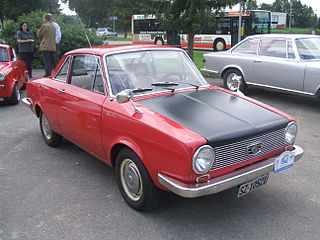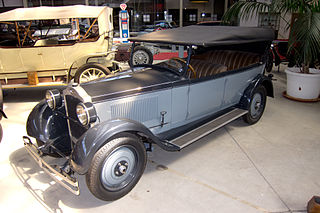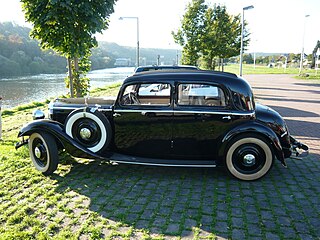
The Ford Eifel is a car manufactured by Ford Germany between 1935 and 1940. It initially complemented, and then replaced, the Ford Köln. It was itself replaced by the Ford Taunus.

The Mercedes-Benz W136 was Mercedes-Benz's main line of inline-four cylinder motorcars from the mid-1930s into the 1950s. The model 170 V made its public debut as successor to the W15 Typ 170 in February 1936. Between 1936 and 1939 it was Mercedes' top selling model.

The Opel Admiral is a luxury car made by the German car manufacturer Opel from 1937 until 1939 and again from 1964 until 1977.

The Adler Diplomat is a substantial six-cylinder “limousine” (saloon) built by the Frankfurt auto-maker, Adler. It was introduced in March 1934 as a direct replacement for the manufacturer's Standard 6. Less directly the six-cylinder Diplomat also replaced the Adler Standard 8 since Adler's large eight-cylinder car was discontinued in 1934 without a direct replacement of its own.

The Mercedes-Benz W15 is an automobile produced by Mercedes-Benz from 1931 to 1936. Regarded today as a mid-size family car, it was given the chassis designation W15, and sold as the Typ 170 in four-door "Limousine" (sedan/saloon) and Cabriolet forms.

The Ford Taunus G93A is a small family car that was produced by Ford Germany between 1939 and 1942 in succession to the Ford Eifel. It was the first car developed at Cologne by Ford Germany which previously had built cars originated by Ford businesses in the US or the UK. Production began on 30 April 1939, with the first car exhibited to the public in June 1939, less than six months before the outbreak of war in Europe.

The Glas 1004 is a small two-door, four-seater automobile produced by Hans Glas GmbH at Dingolfing. It was first exhibited in public, in coupé form, at the Frankfurt Motor Show in September 1961. Volume production of the 1004 coupé started in May 1962, and in January 1963 saloon/sedan and cabriolet versions joined the range along with the more powerful Glas 1204. September 1965 saw a yet more powerful variant, the Glas 1304. In September 1966, a fastback Kombilimousine (estate) was added. The 04s were produced at least until December 1967, and new cars were listed for sale through much of 1968.

The DKW Typ 4=8 is a small rear-wheel drive two-stroke V4 engined car produced at the company's Spandau plant by DKW. It was launched at the Berlin Motor-show in 1929 as a successor to the DKW Typ P built at the same factory, although the DKW Typ P 4=8 was significantly larger than the Typ P: in terms of market positioning a more direct successor to the DKW Type P was probably the DKW F1 produced in Zwickau from 1931.

The Adler Standard 6 was the most important newcomer at the Berlin Motor Show in October 1926. It was a substantial six cylinder “limousine” (saloon) built by the Frankfurt auto-maker, Adler. Other body styles were available from coach builders. The model continued to be produced until 1934.

The Adler 2.5-litre was a sensation when first presented by Adler at the Berlin Motor Show early in 1937, although this did not convert into correspondingly sensational sales.

The Adler Favorit is a passenger car introduced early in 1929 by the Frankfurt auto-maker, Adler. It was a substantial six cylinder “limousine” (saloon) closely modelled on the manufacturer’s Standard 6 which had first appeared in public in October 1926. The two models shared the same 2,840 mm (112 in) wheelbase, but the Favorit was powered by a smaller 1,943 cc 4-cylinder engine for which a maximum power output of 35 PS was claimed. For both cars, a range of alternative body styles were available from coach builders.
The Adler Standard 8 is a large passenger car introduced in 1928 by the Frankfurt auto-maker, Adler. It was a big eight cylinder “limousine” (saloon) closely modelled on the manufacturer’s Standard 6 which had first appeared in public in October 1926. However the Standard 8 had a longer 3,325 mm (130.9 in) wheelbase as well as a 50 mm (2.0 in) wider track. Although it closely resembled the Standard 6, the Standard 8 was larger all round. The Standard 8 engine had eight cylinders, but individually the cylinder dimensions, at 75 mm (3.0 in) x 110 mm (4.3 in), were identical to those on the six cylinder car as well as on the four cylinder with the Adler Favorit which appeared in 1929.

The Adler Trumpf is a small family car introduced by the Frankfurt based auto-maker, Adler in March 1932, with Trumpf production fully starting in the late summer that year. In a move reminiscent of British Leyland in the 1970s, Adler launched two similarly sized cars in the same year, one of which followed the 1931 DKW F1's then innovative front-wheel drive layout, and the other model using the conventional rear-wheel drive configuration still used by then market leader, Opel's 1.2 litre 'model 6'.

The Adler Trumpf Junior is a small family car introduced by the Frankfurt based auto-maker Adler, early in 1934. Trumpf Junior was conceived as a similar but smaller version of the Adler Trumpf, which had already been available for two years. It intended to broaden the range and claim a share of a growing market which DKW were creating with their F1 model, and its successors, for small inexpensive front wheel drive cars.

The Adler 2-litre is a medium-sized family car introduced by the Frankfurt based auto-maker, Adler in February 1938, as a replacement for the Adler Trumpf.

The Opel 1,2 Liter is a small car manufactured by Opel between 1931 and 1935. The 1,2 Liter was replaced in 1935 by the Opel P4 which was broadly similar but employed a new engine and continued in production until December 1937. For just one year, in 1933, the manufacturer also offered the Opel 1,0 Liter which was a smaller engined version of the 1,2 Liter. The Opel 1,2 Liter replaced the last version of the Opel Laubfrosch and was itself first complemented and then effectively replaced by the more roomy Opel Kadett, which had itself already entered production in 1935.

The Opel 7/34 PS is a large but relatively inexpensive six-cylinder-powered car manufactured by Opel, introduced in October 1927. It was replaced in 1928 by the Opel 8/40 PS which was virtually identical except that the cylinder capacity had been increased. Significant changes to the chassis took place in February 1929, after which production of the model continued till September 1930. The 8/40 PS was replaced by the Opel 1.8 Liter in 1931, also a compact six-cylinder car.

The Mercedes-Benz W 21 was a six-cylinder passenger car launched in 1933 using the name Mercedes-Benz Typ 200. It was one of several Mercedes-Benz models known, in its own time, as the Mercedes-Benz 200 and is therefore in retrospect more commonly referred to using its Mercedes-Benz works number, “W21”.

The Mercedes-Benz W 142 was a six-cylinder passenger car launched in February 1937, as a successor to the Mercedes-Benz Typ 290. The car was known by its name Typ 320 at the time of its production and service, but is in retrospect commonly referred to using its Mercedes-Benz works number, "W142", which gives a more unambiguous, unique nomenclature.

The Mercedes-Benz W18 was a six-cylinder automobile introduced as the Mercedes-Benz Typ 290 in 1933. It was a smaller-engined successor to the manufacturer’s Typ 350 / 370 Mannheim model. In terms of the German auto-business of the 1930s it occupied a market position roughly equivalent to that filled by the Mercedes-Benz E-Class in the closing decades of the twentieth century. The W18 was replaced in 1937 by the manufacturer’s W142.



















